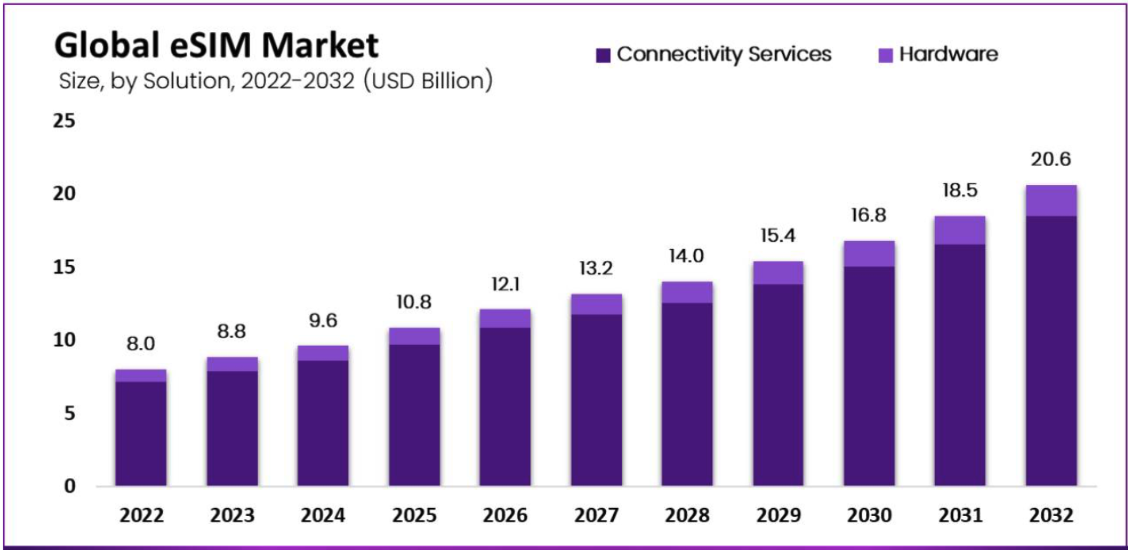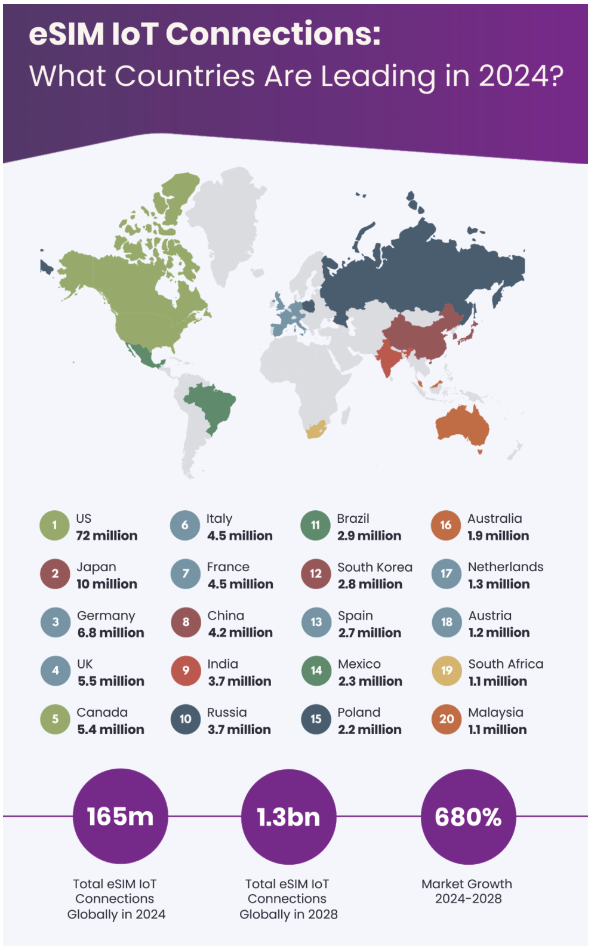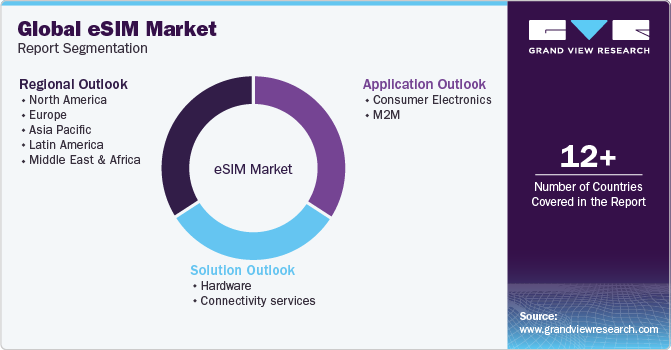
Unlocking the Potential of eSIM Across Sectors
Key takeaways:
- The key applications and use cases of eSIM technology across different industries.
- The challenges and considerations in adopting eSIM technology.
- Future prospects and strategic recommendations for businesses looking to implement eSIM solutions.
As digital connectivity advances, eSIM technology is leading the charge in shaping how we interact with our devices.
What Is an Esim?
Unlike traditional SIM cards, eSIMs are embedded directly into devices, allowing users to switch carriers effortlessly through software commands. This innovation brings unparalleled flexibility, security, and convenience, setting the stage for a new era in telecommunications.
The adoption of eSIM technology has accelerated since its initial use in IoT devices in 2010 and its integration by industry giants like Apple and Samsung in 2016. The eSIM market, valued at USD 8.8 billion in 2023, is projected to grow to approximately USD 20.6 billion by 2032. This significant expansion underscores the transformative potential of eSIMs across various sectors.
Join us as we delve into the innovative world of eSIM technology and its impact on global connectivity.

Revolutionizing Connectivity Across Industries: How Does an eSIM work?
eSIM technology is being adopted across various industries, revolutionizing the way devices connect and interact with networks. Here are some of the key applications and use cases that highlight the transformative potential of eSIMs.
Consumer Electronics: Flexibility and Convenience
One of the most visible applications of eSIM technology is in consumer electronics. Devices such as smartphones, tablets, and smartwatches benefit significantly from eSIM integration. eSIMs allow users to switch carriers without needing to change physical SIM cards. This switch offers greater flexibility and convenience.
For instance, Apple’s adoption of the eSIM in its iPhone and Apple Watch models has enabled seamless carrier switching and dual-SIM functionality, enhancing user experience and connectivity options.
Automotive Industry: Enhancing Vehicle Connectivity
The automotive industry is leveraging eSIM technology to enhance vehicle connectivity. Embedded SIMs enable cars to maintain a constant connection to mobile networks, supporting a range of applications from navigation and infotainment to emergency services and remote diagnostics.
The continuous connectivity through eSIM tech is crucial for the development of autonomous vehicles and advanced driver-assistance systems (ADAS). Companies like Tesla and BMW are integrating eSIMs to provide over-the-air updates and real-time data analytics, improving vehicle performance and safety.
Internet of Things (IoT): Seamless Device Integration
eSIMs are a cornerstone of the IoT ecosystem, enabling seamless connectivity for a wide range of devices. From smart home appliances to industrial sensors, eSIM technology supports efficient network management and device mobility.
The ability to remotely provision and manage network profiles makes eSIMs ideal for IoT applications, where devices often operate in remote or hard-to-reach locations.
A great example is that of logistics companies. These companies can use eSIMs to track devices and monitor shipments globally, ensuring real-time visibility and control over supply chains.

Wearable Technology: Compact and Connected
Wearable devices such as fitness trackers and health monitors are also benefiting from eSIM integration. These devices require constant connectivity to provide real-time data and insights. eSIMs eliminate the need for physical SIM cards, allowing for smaller, more compact designs. This enhances the functionality and user experience of wearable technology.
Enterprise Solutions: Streamlining Business Operations
Businesses are adopting eSIM technology to streamline operations and improve connectivity for their mobile workforce. eSIMs provide flexible, scalable solutions for managing mobile devices across multiple regions and carriers. This is particularly beneficial for multinational companies that require reliable and secure connectivity for their employees. Enterprises can remotely manage network profiles, reducing the complexity and cost associated with physical SIM card distribution and replacement.
eSIM technology is driving innovation across various sectors, offering enhanced connectivity, flexibility, and convenience. As more industries adopt eSIMs, the potential for new applications and improved services continues to grow.
Tackling the Challenges and Considerations of eSIM Adoption
While eSIM technology offers numerous benefits, its adoption and implementation come with several challenges and considerations. Addressing these issues is crucial for maximizing the potential of eSIMs across various industries.
Navigating Regulatory and Compliance Issues
One of the primary challenges in adopting eSIM technology is navigating the complex regulatory landscape. Different countries have varying regulations regarding telecommunications, data privacy, and security. Compliance with these regulations is essential to ensure legal operations and protect user data.
For instance, the European Union’s General Data Protection Regulation (GDPR) imposes strict requirements on data handling, which can complicate eSIM deployment. Telecom operators and device manufacturers must work closely with regulatory bodies to ensure compliance and avoid legal complications.
Overcoming Technological Integration Barriers
Integrating eSIM technology into existing systems and infrastructure poses significant technological challenges. This involves updating network infrastructure to support eSIM provisioning and management, as well as ensuring compatibility with a wide range of devices.
Telecom operators need to invest in new platforms and systems that can handle remote SIM provisioning and management. Additionally, there may be interoperability issues between different eSIM platforms and devices, requiring industry-wide standards and collaboration to resolve.
Addressing Security Concerns
Security is a critical concern for eSIM technology, given the sensitive nature of the data being transmitted and stored. eSIMs must be designed with robust security measures to protect against unauthorized access, hacking, and other cyber threats. This includes implementing advanced encryption techniques, secure authentication protocols, and regular security updates. The potential for remote attacks on eSIM-enabled devices makes it essential for manufacturers and service providers to prioritize security in their development and deployment processes.
Enhancing Consumer Awareness and Acceptance
Another challenge is consumer awareness and acceptance of eSIM technology. Many users are accustomed to physical SIM cards and may be hesitant to switch to eSIMs due to concerns about compatibility, security, and ease of use.
Educating consumers about the benefits and security features of eSIM technology is crucial to drive adoption. Additionally, ensuring a seamless user experience with easy activation and carrier switching processes can help build consumer confidence in eSIMs.
Managing Cost and Investment
Deploying eSIM technology requires significant investment in infrastructure, systems, and training. Telecom operators and device manufacturers must allocate substantial resources to develop and implement eSIM solutions. This includes upgrading existing infrastructure, developing new platforms for eSIM management, and training staff to handle eSIM-related processes. While the long-term benefits of eSIM technology are substantial, the initial costs can be a barrier for some companies.
By addressing these challenges, businesses can successfully integrate eSIM technology and unlock its full potential. Collaboration between industry stakeholders, regulatory bodies, and technology providers is essential to overcome these obstacles and drive the widespread adoption of eSIMs.
Emerging Trends in eSIM Technology
The adoption of eSIM technology is rapidly expanding across various sectors, particularly in consumer electronics. Manufacturers are increasingly incorporating eSIM capabilities into a wider range of devices, beyond just smartphones, tablets, smartwatches, and laptops. This trend is expected to continue, enhancing both connectivity and user convenience across more everyday gadgets.
In the realm of the Internet of Things (IoT), eSIM technology is poised to play a crucial role. The ability to remotely manage connectivity for numerous devices makes eSIMs ideal for IoT applications, including smart home devices, industrial sensors, and connected vehicles. This capability will drive significant growth in the IoT sector.
Security remains a top priority in the development of eSIM technology. As eSIMs are adopted in increasingly sensitive sectors such as financial services and healthcare, advancements in encryption, authentication, and secure provisioning will be crucial to protect against cyber threats and ensure secure connectivity.
The automotive industry is on the brink of significant eSIM adoption. Connected cars and autonomous vehicles will rely on eSIMs for reliable connectivity, enabling features such as real-time navigation, vehicle-to-everything (V2X) communication, and over-the-air updates. These enhancements will improve vehicle safety and performance.

Strategic Recommendations for Businesses to Maximize eSIM Technology Benefits
Businesses looking to leverage the benefits of eSIM technology should consider several strategic actions:
- Invest in Infrastructure and Technology: Upgrade network capabilities and implement remote provisioning platforms. Ensure compatibility across a wide range of devices.
- Form Strategic Partnerships: Collaborate with technology providers, telecom operators, and industry stakeholders to access the latest innovations and regulatory expertise.
- Focus on Security and Compliance: Prioritize robust security measures and ensure compliance with regulatory standards. Regularly conduct security audits and updates.
- Educate and Engage Consumers: Raise awareness about eSIM benefits and ease of use. Provide a seamless user experience through simple activation processes and reliable customer support.
- Leverage Data and Analytics: Utilize data generated by eSIM technology to gain insights into user behavior, network performance, and market trends. Optimize services and identify new growth opportunities.
The future of eSIM technology is promising, with its impact expected to span various industries and applications. By embracing these emerging trends and implementing strategic measures, businesses can unlock significant benefits and drive technological advancements in connectivity.
Unlocking the Full Potential of eSIM Technology
eSIM technology is revolutionizing the landscape of digital connectivity, offering unprecedented flexibility, security, and convenience. By eliminating the need for physical SIM cards, eSIMs enable seamless carrier switching and enhanced connectivity for a wide range of devices, from consumer electronics to industrial IoT applications.
To delve deeper into the transformative potential of eSIM technology and stay updated with the latest market insights, consider signing up for a free entrapeer account. Access comprehensive research, detailed reports, and tailored recommendations that can drive your strategic decisions and help you navigate the evolving connectivity landscape.

